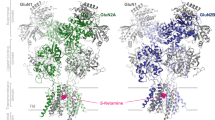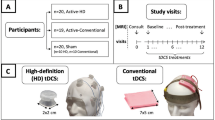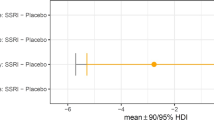Abstract
Serotonin affects memory formation via modulating long-term potentiation (LTP) and depression (LTD). Accordingly, acute selective serotonin reuptake inhibitor (SSRI) administration enhanced LTP-like plasticity induced by transcranial direct current stimulation (tDCS) in humans. However, it usually takes some time for SSRI to reduce clinical symptoms such as anxiety, negative mood, and related symptoms of depression and anxiety disorders. This might be related to an at least partially different effect of chronic serotonergic enhancement on plasticity, as compared with single-dose medication. Here we explored the impact of chronic application of the SSRI citalopram (CIT) on plasticity induced by tDCS in healthy humans in a partially double-blinded, placebo (PLC)-controlled, randomized crossover study. Furthermore, we explored the dependency of plasticity induction from the glutamatergic system via N-methyl-D-aspartate receptor antagonism. Twelve healthy subjects received PLC medication, combined with anodal or cathodal tDCS of the primary motor cortex. Afterwards, the same subjects took CIT (20 mg/day) consecutively for 35 days. During this period, four additional interventions were performed (CIT and PLC medication with anodal/cathodal tDCS, CIT and dextromethorphan (150 mg) with anodal/cathodal tDCS). Plasticity was monitored by motor-evoked potential amplitudes elicited by transcranial magnetic stimulation. Chronic application of CIT increased and prolonged the LTP-like plasticity induced by anodal tDCS for over 24 h, and converted cathodal tDCS-induced LTD-like plasticity into facilitation. These effects were abolished by dextromethorphan. Chronic serotonergic enhancement results in a strengthening of LTP-like glutamatergic plasticity, which might partially explain the therapeutic impact of SSRIs in depression and other neuropsychiatric diseases.
Similar content being viewed by others
Log in or create a free account to read this content
Gain free access to this article, as well as selected content from this journal and more on nature.com
or
References
Acler M, Robol E, Fiaschi A, Manganotti P (2009). A double blind placebo RCT to investigate the effcts of serotonergic modulation on brain excitability and motor recovery in stroke patients. J Neurol 256: 1152–1158.
Batsikadze G, Paulus W, Kuo M, Nitsche M (2013). Effect of serotonin on paired associative stimulation-induced plasticity in the human motor cortex. Neuropsychopharmacology 38: 2260–2267.
Bert B, Fink H, Rothe J, Walstab J, Bonisch H (2008). Learning and momory in 5-HT(1A)-receptor mutant mice. Behav Brain Res 195: 78–85.
Bezchilbnyk-Butler K, Aleksic I, Kennedy S (2000). Citalopram- a review pf pharmachological and clinical effects. J Psychiatry Neurosci 25: 241–254.
Brunoni A, Valiengo L, Baccaro A, Zanao T, Oliveira Jd, Goulart A (2013). The sertraline vs electrical current therapy for treating depression clinical study: results from a factorial, randomized, controlled trial. JAMA Psychiatry 70: 1–9.
Consolo S, Arnaboldi S, Giogi S, Russi G, Ladinsky H (1994). 5-HT4 receptor stimulation facilitates acetylcholine release in rat frontal cortex. Neuroreport 5: 1230–1232.
Criti A, Malenka R (2008). Synaptic plasticity: multiple foms, functions, and mechanisms. Neuropsychopharmachology 33: 18–41.
Foy M, Stanton M, Levine S, Thompason R (1987). Behavioral stress impairs long-term potentiation in rodent hippocampus. Behav Neural Biol 48: 138–149.
Frensnoza S, Paulus W, Nitsche MA, Kuo MF (2014). Nonlinear dose-dependent impact of D1 receptor activation on motor cortex plasticity in humans. J Neurosci 34: 2744–2753.
Gu Q (2002). Neuromodulatory transmitter systems in the cortex and their role cortical plasticity. Neuroscience 111: 815–835.
Henn FA, Vollmayr B (2004). Basic pathophysiological mechanisms in depression: what are they and how might they affect the course of the illness? Pharmacopsychiatry 37 (Suppl 2): S152–S156.
Holderbach R, Clark K, Moreu J, Bischofberger J, Norman C (2007). Enhanced long-term synaptic depression in an animal model of depression. Biol Psychiatry 62: 373–380.
Huang Y, Kandel E (2007). 5-Hydroxytryptamine induces a protein kinase a mitogen-dependent protein kinase-mediated and macromolecular synthesis-dependent late phase of long-term potentiation in the amagdala. J Neurosci 27: 3111–3119.
Jacobs BL, Formal C (1997). Serotonin and motor activity. Curr Opin Neurobiol 7: 820–825.
Kemp A, Manahan-Vaughan D (2005). The 5-hydroxytryptamine4 receptor exhibits frequnecy-dependent properties in synaptic plasticity and behavioral metaplasticity in the hippocampal CA1 region in vivo. Cereb Cortex 15: 1037–1043.
Kojic L, Gu Q, Douglas R, Cynader M (1997). Serotonin facilitates synaptic plasticity in kitten visual cortex: an in vitro study. Brain Res DEv Brain Res 101: 299–304.
Kojima T, Matsumoyo M, Yogashi H, Tachibana K, Kemmotsu O, Yoshioka M (2003). Fluvoxamine suppress the long-term potentiation in the hippocampal CA1 field of anesthetized rats: an effect medisted via 5-HT 1A receptors. Brain Res 959: 165–168.
Kulla A, Manahan-Vaughan D (2002). Mosulation by serotonin 5-HT(4) receptors of long-term potentiation and depotentiation in the dentate gyrus of freely mobing rats. Cereb Cortex 12: 150–162.
Kuo MF, Paulus W, Nitsche MA (2008). Boosting focally-induced brain plasticity by dopamine. Cereb Cortex 18: 648–651.
Kuo MF, Paulus W, Nitsche MA (2014). Therapeutic effects of non-invasive brain stimulation with direct currents (tDCS) in neuropsychiatric diseases. Neuroimage 15: 948–960.
Liebetanz D, Nitsche M, Tergau F, Paulus W (2002). Pharmacological approach to synaptic and membrane mechanisms of DC-induced neuroplasticity in man. Brain 125: 2238–2247.
Lisman J (2001). Three Ca2+ levels affect plasticity differently: the LTP zone, the LTD zone and no man's land. J Physiol 532: 285.
Monte-Silva K, Liebetanz D, Grundey J, Paulus W, Nitsche M (2010). Dosage-dependent non-linear effect of L-dopa on human motor cortex plasticity. J Physiol 588: 3415–3424.
Mori K, Togashi H, Kojima T, Matsumoto M, Ohaishi S, Ueno K et al (2001). Different effects of anxiolytic agents, diazeoam and 5-HT(1A) agonist tandospirone, on hippocampal long-term potentiation in vivo. Pharmacol Biochem Behav 69: 367–372.
Nitsche M, Grundey J, Liebetanz D, Lang N, Tergau F, Paulus W (2004). Catecholaminergic consolidation of motor cortical neuroplasticity in humans. Cereb Cortex 14: 1240–1245.
Nitsche MA, Cohen LG, Wassermann EM, Priori A, Lang N, Antal A et al (2008). Transcranial direct surrent stimulation: state of art 2008. Brain Stimul 1: 206–223.
Nitsche MA, Fricke K, Henschke U, Schlitterlau A, Liebtanz D, Lang N et al (2003b). Pharmacological modulation of cortical excitability shifts induced by transcrnial DC stimulation. J Physiol 533: 293–301.
Nitsche MA, Klein C, Tergau F, Rothwell J, Paulus W (2003a). Level of action of cathodal DC polarization induced inhibition of the human motor cortex. Clin Neurophysiol 144: 600–604.
Nitsche MA, Kuo M, Karrasch R, Warden B, Liebtanz D, Paulus W (2009). Serotonin affects transcrnial direct current (tDCS)-induced neuroplasticity in humans. Biol Psychiatry 66: 503–508.
Nitsche MA, Paulus W (2000). Excitability changes induced in the human motor cortex by weak transcranial direct current stimulation. J Physiol 527: 633–639.
Nitsche MA, Paulus W (2001). Sustained excitability elevations induced by transcranial DC motor cortex stimulation in humans. Neurology 57: 1899–1901.
Nitsche MA, Roth A, Kuo NF, Fischer AK, Liebetanz D, Lang N (2007). Timing-dependent modulation of associative plasticity by general network excitability in the human motor cortex. J Neurosci 27: 3807–3812.
Normann C, Clark K (2005). Selective modulation of Ca(2+) influx pathways by 5-HT regulates synaptic long-term plasticity in the hippocampus. Brain Res 1037: 187–193.
Normann C, Schmitz D, Furmaier A, Doing C, Bach M (2007). Long-term platsicity of visually evoked potentials in humans is altered in major depression. Biol Psychiatry 62: 373–380.
Panicker MM, Parker I, Miledi R (1991). Receptors of the serotonin 1C subtype expressed from cloned DNA mediate the closing of K+ membrane channels encoded by brain mRNA. Proc Natl Acad Sci USA 88: 2560–2562.
Park S, Jang H, Cho K, Kim M, Yoon S, Rhie D (2012). Developmental switch of the serotonergic role in the induction of synaptic long-term potentiarion in the rat visual cortex. Korean J Physiol Pharmacol 16: 65–70.
Pittenger C, Duman R (2007). Stress, depression and neuroplasticity: a convergence of mechanisms. Neuropharmachology 33: 88–109.
Player MJ, Taylor JL, Weikert CS, Alonzo A, Sachdev PS, Martin D et al (2014). Increase in PAS-induced neuroplasticity after a treatment course of transcranial direct current stimulation for depression. J Affect Disord 167: 140–147.
Rajji TK, Sun Y, Zomorrodi-Moghaddam R, Farzan1 F, Blumberger DM, Benoit Mulsant BH et al (2013). PAS-induced potentiation of cortical-evoked activity in the dorsolateral prefrontal cortex. Neuropsychopharmacology 38: 2545–2552.
Reiser G, Donie F, Binmoller FJ (1989). Serotonin regulates cytosolic Ca2+ activity and membrane potential in a neuronal and in a glial cell line via 5-HT3 and 5-HT2 receptors by different mechanisms. J Cell Sci 93: 545–555.
Savaskan E, Muller S, Boehringer A, Schulz A, Schaechinger H (2008). Antidepressive therapy with escitalopram improves mood, cognitive sumptoms, and identity memory for angry faces in elderly depressed patients. Int J Neuropsychopharmacol 11: 381–388.
Schaechter J (2004). Motor rehabilitation and brain plasticity after hemiparetic stroke. Prog Neurobiol 73: 61–72.
Stassen HH, Angst J (2012). Delayed onset of action of antidepressant. CNS Drugs 9: 177–184.
Staubli U, Otaky N (1994). Serotonin controls the magnitude of LTP induced by theta bursts via action on NMDApreceptor-mediated responses. Brain Res 643: 10–16.
Stephan K, Kunesch E, Cohen LG, Benecke R, Classen J (2000). Induction of plasticity in the human motor cortex by paired associative stimulation. Brain 123: 572–584.
Thirugnanasambandam N, Grundey J, Paulus W, Nitsche MA (2011). Dose-dependent nonlinear effect of L-DOPA on paired associative stimulation-induced neuroplasticity in humans. J Neurosci 31: 5294–5299.
Wood MD, Wren PB (2008). Serotonin-dopamine interactions: omplications for the design of novel therapeitic agents for psychiatric disorders. Prog Brain Res 172: 213–230.
Ziemann U, Paulus W, Nitsche M, Pascual-Leone A, Byblow W, Berardelli A et al (2008). Consesus: motor cortex plasticity protocols. Brain Stimul 1: 164–182.
Acknowledgements
WP is a member of Advisory Boards of GSK, UCB, Desitin. MAN is a member of the Advisory Board of Neuroelectrics. H-IK is supported by the government scholarship, Republic of China (Taiwan). This study was supported by the BMBF-project, “Netzwerk psychische Erkrankungen”, grant 01EE1403C. M-FK, H-IK, AJ, and GB received no financial support or compensation from any individual or corporate entity over the past 3 years for research or professional service and there are no personal financial holdings that could be perceived as constituting a potential conflict of interest.
Author information
Authors and Affiliations
Corresponding author
Rights and permissions
About this article
Cite this article
Kuo, HI., Paulus, W., Batsikadze, G. et al. Chronic Enhancement of Serotonin Facilitates Excitatory Transcranial Direct Current Stimulation-Induced Neuroplasticity. Neuropsychopharmacol 41, 1223–1230 (2016). https://doi.org/10.1038/npp.2015.270
Received:
Revised:
Accepted:
Published:
Issue date:
DOI: https://doi.org/10.1038/npp.2015.270
This article is cited by
-
High-definition transcranial direct current stimulation (HD-tDCS) as augmentation therapy in late-life depression (LLD) with suboptimal response to treatment—a study protocol for a double-blinded randomized sham-controlled trial
Trials (2022)
-
Effect of medication therapy combined with transcranial direct current stimulation on depression and response inhibition of patients with bipolar disorder type I: a clinical trial
BMC Psychiatry (2021)
-
Efficacy and safety of transcranial direct current stimulation as an add-on treatment for obsessive-compulsive disorder: a randomized, sham-controlled trial
Neuropsychopharmacology (2021)
-
Expanding the parameter space of anodal transcranial direct current stimulation of the primary motor cortex
Scientific Reports (2019)
-
Hypericum perforatum extract modulates cortical plasticity in humans
Psychopharmacology (2018)



